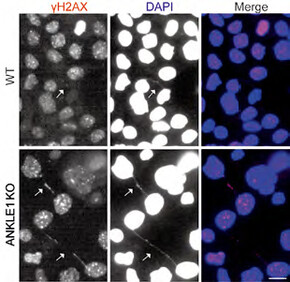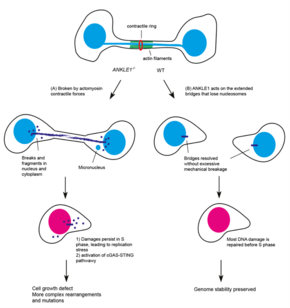

Images adapted from the journal paper.
 Lead Researchers // Professor Ying Wai CHAN, Assistant Professor of the School and Biological Sciences and his Postdoctoral Fellow Dr Huadong JIANG
Lead Researchers // Professor Ying Wai CHAN, Assistant Professor of the School and Biological Sciences and his Postdoctoral Fellow Dr Huadong JIANG Collaborator // The Francis Crick Institute
Imagine untangling two intertwined yarn balls, and the threads represent chromosomes. The balls are connected by a delicate strand, and if you pull too hard, the strand might snap. Similarly, during cell division, threadlike structures called chromatin bridges can form between dividing cells. Mishandling these bridges can lead to damage, just like pulling too hard on the yarn balls might break them.
Our researchers have identified a unique enzyme within our cells called ANKLE1. This enzyme acts as ‘scissors’, cutting these unwanted threads to ensure cells divide cleanly without damage. Our findings suggest that without ANKLE1, these bridges could lead to significant issues, including DNA damage and potentially confusing our body’s defence system, promoting it to attack our own cells.
Our researchers have identified a unique enzyme within our cells called ANKLE1. This enzyme acts as ‘scissors’, cutting these unwanted threads to ensure cells divide cleanly without damage. Our findings suggest that without ANKLE1, these bridges could lead to significant issues, including DNA damage and potentially confusing our body’s defence system, promoting it to attack our own cells.
Grasping the role of this enzyme is pivotal. It may lead us to strategies to maintain cell health and combat diseases like cancer, characterised by uncontrolled cell growth. Understanding ANKLE1 guides scientists in ensuring optimal cell function.
研究團隊發現了剔除ANKLE1 將導致DNA 纖維橋災難性斷裂,引發大量DNA 損傷,破壞基因組穩定性和激活先天免疫反應。
Journal paper: Transcriptome age of individual cell types in Caenorhabditis elegans (published in PNAS, 2023)
| < Previous | Next > |

